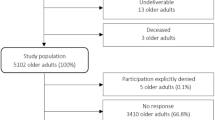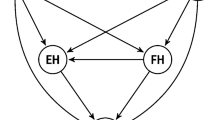Abstract
Background
Age-related differences in the way ratings of health related quality of life (HRQL) are produced are poorly understood, especially for older women.
Objective
To examine age differences in critical dimensions of HRQL among older women using structural equation modelling. We hypothesized that physical, mental and social health domains would exert weaker total effects on HRQL among older middle-aged versus much older women.
Methods
A model of HRQL was developed and confirmatory factor analysis (CFA) was used to test the structure of the model across two samples of community-dwelling women aged 55 years and older. The relationships between the constructs and the relative magnitude of direct and indirect effects on HRQL were evaluated in a series of path models, with women younger and older than age 70 tested separately.
Results
The CFA model of HRQL showed excellent fit in both the national and verification samples (RMSEA 0.04 and 0.02 respectively). In the path model, the total effects of physical, mental and social health on general perceptions of HRQL were greater and more significant in middle-aged versus older women (beta coefficients 0.810, 0.277, 0.266, all P < 0.05 versus, 0.700, 0.189, and 0.057, P < 0.05 for physical and mental health only respectively).
Conclusion
This HRQL model suggests different opportunities for intervention among older women to improve the outcomes along the path to HRQL.


Similar content being viewed by others
References
Wilson, I. B., & Cleary, P. D. (1995). Linking clinical variables with health-related quality of life. The Journal of the American Medical Association, 273, 59–5.
Ustun, T. B., Chatterji, S., Bickenbach, J., Kostanjsek, N., & Schneider, M. (2003). The international classification of functioning, disability and health: A new tool for understanding disability and health. Disability and Rehabilitation, 25, 565–71.
International Classification of Functioning, Disability and Health. (2002). Beginner’s guide. Geneva: World Health Organization.
Sullivan, M. D., Kempen, I. J. M., Van Sonderen, E., & Ormet, J. (2000). Models of quality of life in a population of community-dwelling Dutch elderly. Quality of Life Research, 9, 801–10
Johnson, R. J., & Wolinsky, F. D. (1993). The structure of health status among older adults: Disease, disability, functional limitation, and perceived health. Journal of Health and Social Behavior, 34, 105–20.
Jans, L., & Stoddard, S. (1999). Chartbook on women and disability in the United States. An InfoUse Report. Washington, DC: U.S. National Institute on Disability and Rehabilitation Research.
Manton, G., Corder, L., & Stallard, E. (1997). Chronic disability trends in elderly United States populations: 1982–994. Proceedings of the National Academy of Sciences of the United States of America, 94, 2593–598.
Newman, A. B. (1999) Cognition and frailty in older women: Socioeconomic and physiologic influences. In R. B. Ness & L. H. Kuller (Eds.), Health and disease among women: Biological and environmental influences (pp. 86–11). New York: Oxford University Press.
Hopman, W. M., Towheed, T., Anastasssiades, T. et al. (2000). Canadian normative data for the SF-36 health survey. Canadian Medical Association Journal, 163, 265–71.
Jenkinson, C., Stewart-Brown, S., Petersen, S., & Paice, C. (1999). Assessment of the SF-36 version 2 in the United Kingdom. Journal of Epidemiology and Community Health, 53, 45–0.
Ware, J. E. Jr., Snow, K. K., Kosinski, M., & Gandek, B. (1993). SF-36 manual and interpretation guide. Boston: The Health Institute, New England Medical Center.
Sullivan, M., & Karlsson, J. (1998). The Swedish SF-36 Health Survey III. Evaluation of criterion-based validity: Results from normative population. Journal of Clinical Epidemiology, 51, 1105–3.
Aaronson, N. K., Muller, M., Cohen, P. D. A., Essink-Bot, M. L., Fekkes, M., Sanderman, R. et al. (1989). Translation, validation, and norming of the Dutch language version of the SF-36 Health Survey in community and chronic disease populations. Journal of Clinical Epidemiology, 51, 1055–068.
Idler, E. L. (2003). Discussion: Gender differences in self-rated health in mortality and in the relationship between the two. The Gerontologist, 43, 372–75.
Lee, Y. (2000). The predictive value of self assessed general physical and mental health on functional decline and mortality in older adults. Journal of Epidemiology and Community Health, 54, 123–29.
Idler, E., & Binyamini Y. (1997). Self-rated health and mortality: A review of twenty-seven community studies. Journal of Health and Social Behavior, 38, 21–7.
Helmer, C., Barberger-Gateau, P., Letenneur, L., & Dartigues, J. F. (1999). Subjective health and mortality in French elderly women and men. The Journals of Gerontology. Series B. Psychological Sciences and Social Sciences, 54, S84–S92.
Deeg, D. J. H., & Kriegsman, D. M. W. (2003). Concepts of self-rated health: Specifying the gender difference in mortality risk. The Gerontologist, 43, 376–86.
Power, C., Matthews, S., & Manor, O. (1998). Ineqalities in self-rated health: Explanations from different stages of life. Lancet, 351, 1009–014.
Baltes, P. B., Staudinger, U. M., & Lindenberger, U. (1999). Lifespan psychology: Theory and application to intellectual functioning. Annual Review of Psychology, 50, 471–07.
Rothermund, K., & Brandtstadter, J. (2003). Coping with deficits and losses in later life: From compensatory action to accommodation. Psychology and Aging, 18, 896–05.
Turk-Charles, S., Mather, M., & Carstensen, L. L. (2003). Aging and emotional memory: The forgettable nature of negative images for older adults. Journal of Experimental Psychology, 132, 310–24.
Heckhausen, J., & Brim, O. G. (1997). Perceived problems for self and others: Self-protection by social downgrading throughout adulthood. Psychology and Aging, 12, 610–19.
Tannenbaum, C., Mayo, N., & Ducharme, F. (2005). Older women’s health priorities and perceptions of care delivery: Results of the WOW health survey. Canadian Medical Association Journal, 173, 153–59.
Tannenbaum, C., & Mayo, N. (2003). Women’s health priorities and perceptions of care: A survey to identify opportunities for improving preventative health care delivery for older women. Age Ageing, 32, 626–35.
Madden, R., Choi C., & Sykes C. (2003). The ICF as a framework for national data: The introduction of ICF into Australian data dictionaries. Disability and Rehabilitation, 25, 676–82.
Cieza, A., Brockow, T., Ewert, T., Amman, E., Kollerits, B., Chatterji, S., Ustun, T. B., & Stucki, G. (2002). Linking health-status measurements to the international classification of functioning, disability and health. Journal of Rehabilitation Medicine, 34, 205–10.
Ware, J. E., Kosinski, M., & Keller, S. D. (1996). A 12-item short-form health survey: Construction of scales and preliminary tests of reliability and validity. Medical Care, 34, 220–33.
Mayo, N. E., Goldberg, M., & Kind, P. (1997). Performance of the Euroqol EQ-5D in a Canadian population. Discussion paper, EuroQol plenary meeting Rotterdam, 2– October 1997.
Kind, P. (1996). The EurolQol Instrument: An index of health-related quality of life. In Quality of life and pharmacoeconomics in clinical trials. Ed: Spilker B. Lippincott-Raven.
Keller, S. D., Ware, J. E., Bentler, P. M., Aaronson, N. K., Alonso, J., Apolone, G., et al. (1998). Use of structural equation modeling to test the construct validity of the SF-36 health survey in ten countries: Results from the IQOLA Project. Clinical Epidemiology, 51, 1179–188.
Wood-Dauphinee, S. L., Opzoomer, M. A., Williams, J. I., Marchand, B., & Spitzer, W.O. (1988). Assessment of global function: The reintegration to normal living index. Archives of Physical Medicine and Rehabilitation, 69, 83–90.
Wood-Dauphinee, S., & Williams, J. I. (1987). Reintegration to normal living as a proxy to quality of life. Journal of Chronic Diseases, 40, 491–99.
Finch, E., Brooks, D., Stratford, P. W., & Mayo, N. E. (Eds). (2002). Physical rehabilitation outcome measures: A guide to enhanced clinical decision making (2nd ed.). Canadian Physiotherapy Association.
Keller, H. H., Hedley, M. R., & Wong Brownlee, S. (2000). The development of seniors in the community: Risk evaluation for eating and nutrition (SCREEN). Canadian Journal of Dietetic Practice and Research, 61, 67–2.
Keller, H. H., McKenzie, J. D., & Goy, R. E. (2001). Construct validation and test-retest reliability of the seniors in the community: Risk evaluation for eating and nutrition questionnaire. The Journals of Gerontology. Series A. Biological Sciences and Medical Sciences, 56A, M552–M558.
Kline, R. B. (1998). Principles and practice of structural equation modeling. New York: The Guilford Press.
Hayduk L. A. (1987). Structural equation modeling with LISREL: Essentials and advances. Baltimore: Johns Hopkins University Press.
Hoyle, R. H. (1995). Structural equation modeling : Concepts, issues, and application. Thousand Oaks: Sage Publications.
Kaplan, D. (1955). Structural equation modeling : Foundations and extensions. Thosand Oaks, CA: Sage Publications.
Bollen K. A. (1989). Structural equations with latent variables. New York: Wiley.
Brown, M. W., & Cudeck, R. (1993). Alternative ways of assessing model fit. In K. A. Bollen & J. S. Long (Eds.), Testing structural models. Newbury Park: Sage Publications.
Hu, L.-T., & Bentler, P. M. (1999). Cutoff criteria for fit indexes in covariance structure analysis: Conventionals criteria versus new alternatives. Stuctural Equation Modeling, 6, 1–5.
Jöreskog K. G., & Sörbom D. (1996). LISREL 8 user’s reference guide. Illinois: Scientific Software International Inc.
Johnson, R. J., & Wolinsky, F. D. (1994). Gender, race, and health: The structure of health status among older adults. The Gerontologist, 34, 24–5.
Fylkesnes, K., & Forde, O. H. (1992). Determinants and dimensions involved in self-evaluation of health. Social Science and Medicine, 35, 271–79.
Fayers, P. M. (2004). Quality-of-life measurement in clinical trials–the impact of causal variables. Journal of Biopharmaceutical Statistics, 14, 155–76.
Author information
Authors and Affiliations
Corresponding author
Appendix
Appendix
Rights and permissions
About this article
Cite this article
Tannenbaum, C., Ahmed, S. & Mayo, N. What drives older women’s perceptions of health-related quality of life?. Qual Life Res 16, 593–605 (2007). https://doi.org/10.1007/s11136-006-9148-2
Received:
Accepted:
Published:
Issue Date:
DOI: https://doi.org/10.1007/s11136-006-9148-2




